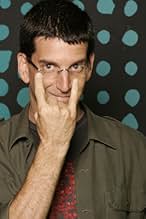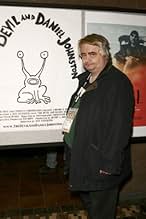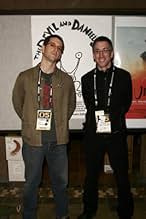IMDb-BEWERTUNG
7,9/10
10.793
IHRE BEWERTUNG
Füge eine Handlung in deiner Sprache hinzuDaniel Johnston, manic-depressive genius singer/songwriter/artist is revealed in this portrait of madness, creativity and love.Daniel Johnston, manic-depressive genius singer/songwriter/artist is revealed in this portrait of madness, creativity and love.Daniel Johnston, manic-depressive genius singer/songwriter/artist is revealed in this portrait of madness, creativity and love.
- Auszeichnungen
- 2 Gewinne & 3 Nominierungen insgesamt
Freddie Mercury
- Self
- (Archivfilmmaterial)
Empfohlene Bewertungen
Many of the great artists of history have suffered from some form of mental disorder, and we often find ourselves fascinated both by their brilliance and their madness. Of course, as this documentary points out, none of us ever had to actually live with a Van Gogh or a Lord Byron and deal with the real world consequences of what went on in their heads.
In The Devil and Daniel Johnston, Jeff Feuerzeig gives us a rare glimpse into the tortured mind of just such brilliant artist by effectively combining interviews from those who have known Daniel Johnston best with Johnston's own internal monologue. Feuerzeig achieves the latter because, apart from recording hundreds of songs on cassette tapes, Daniel recorded much of his life; from his mother screaming at him as a teenager to his arrest by park officials for painting Jesus fish on the Statue of Liberty to Johnston reading aloud about his own mental illness from the Diagnostic and Statistical Manual of Mental Disorders.
Many people came to know Daniel Johnston's work in the early 90s when Kurt Cobain famously called him the "greatest songwriter on Earth" and wore a t-shirt with an image from one of Johnston's hand-drawn album covers on the MTV Video Music Awards. Johnston's raw and introspective songs were subsequently covered by Nirvana, Sonic Youth, The Flaming Lips, Beck, and many others. Sadly, just as his music was making inroads into the popular consciousness Johnston's mental illness worsened (possibly accelerated by heavy LSD use), and his career and life entered increasingly troubled waters.
The Devil and Daniel Johnston works as a documentary about music, art, and mental illness all at the same time. It grants you unusual access to what's going on inside a the mind of a human being bursting with creative talent while simultaneously struggling to control the demons that haunt him. After watching this, don't be surprised if you find yourself wanting to hear more of Daniel Johnston's work.
In The Devil and Daniel Johnston, Jeff Feuerzeig gives us a rare glimpse into the tortured mind of just such brilliant artist by effectively combining interviews from those who have known Daniel Johnston best with Johnston's own internal monologue. Feuerzeig achieves the latter because, apart from recording hundreds of songs on cassette tapes, Daniel recorded much of his life; from his mother screaming at him as a teenager to his arrest by park officials for painting Jesus fish on the Statue of Liberty to Johnston reading aloud about his own mental illness from the Diagnostic and Statistical Manual of Mental Disorders.
Many people came to know Daniel Johnston's work in the early 90s when Kurt Cobain famously called him the "greatest songwriter on Earth" and wore a t-shirt with an image from one of Johnston's hand-drawn album covers on the MTV Video Music Awards. Johnston's raw and introspective songs were subsequently covered by Nirvana, Sonic Youth, The Flaming Lips, Beck, and many others. Sadly, just as his music was making inroads into the popular consciousness Johnston's mental illness worsened (possibly accelerated by heavy LSD use), and his career and life entered increasingly troubled waters.
The Devil and Daniel Johnston works as a documentary about music, art, and mental illness all at the same time. It grants you unusual access to what's going on inside a the mind of a human being bursting with creative talent while simultaneously struggling to control the demons that haunt him. After watching this, don't be surprised if you find yourself wanting to hear more of Daniel Johnston's work.
Gifted but troubled artist makes a comeback with the aid of loving parents and good psychiatric care
Biodoc about Daniel Johnston, a multitalented man, a compulsively prolific cartoon artist, song writer and performer, whose bipolar disorder and drug abuse led to episodes of severe mental illness and destructive behaviors, beginning in his early 20s, in the 1980s, problems that stifled his career for many years, until consistent psychiatric care and kindly parental oversight effected a more stable course for him more recently. Now approaching age 45, Johnston has made a comeback of sorts, reaching a level of artistic self control and productivity that has swept him toward unprecedented recognition.
This film charts Johnston's life and family, ingeniously assimilating materials made by Johnston himself as a kid and young adult - super 8 and video footage; cassette audiotapes; still photos as well as contemporary video interviews and stills. By mid-adolescence he was holed up in the basement of his family's home, staying up all hours, writing songs, drawing, making tapes almost nonstop. By his mid-20s he had run away to Austin, Texas, and made a splash on the pop music scene there. But within a year or two, abetted by lots of marijuana and LSD, he began a series of horrendous manic and depressive episodes that scuttled his career, even as he was beginning to receive recognition locally and on a national level.
For much of the next 15 years Johnston was hospitalized frequently after extremely dangerous manic episodes (he seriously injured one acquaintance with a lead pipe, and later interfered with control of his father's small aircraft, leading to a crash landing that, luckily, both survived), zoned out on medications, and vegetating at the family home in Waller, Texas. But in the past few years his course has stabilized.
He's obese, the result of his mood stabilizing medications and inactivity no doubt, and he's no longer the flamboyant, zany free spirit that titillated and frightened so many of his followers in the past. But the film shows us that he is now in better control of his drawing and singing performances than he ever was years earlier. He has been helped immensely by his parents, Bill and Mabel, now in their early 80s, his agent and owner of a small recording company, Jeff Tartakov, and an Austin music journalist, Louis Black, all of whom have worked hard to help sustain and enhance Johnston's reputation as a creative artist.
Their loyal efforts have been well rewarded. The film demonstrates the success of a show of Johnston's more recent drawings at Gallery Zero One in Los Angeles, where over 90% of the works were sold to a single collector before the exhibition even opened. In 2003 Johnston sang before an audience in Sweden that obviously worshiped him. Cartoonist Matt Groening is a fan of Johnston's. Tom Waits and Beck, among many others, have covered his songs. And just a few weeks ago (subsequent to the film) the Whitney Museum in Manhattan announced that Johnston's works would be included in the 2006 Whitney Biennial.
From a psychiatric perspective, a good case can be made that Johnston does suffer from bipolar disorder. But he was compulsively creating art years before his first episode of mood disorder. Like Vincent Van Gogh and some other compulsive artists, Johnston may also have Asperger's Syndrome.
This film is very well crafted until near the end. Actually it seems as if the filmmakers really didn't know how or when to end it. There are a half dozen moments in the last 20 minutes when they could have done so. See more, including examples of Johnston's art work, at these websites: www.museumoflove.com and www.rejectedunknown.com/feature.htm. My grade: B+ 8/10.
This film charts Johnston's life and family, ingeniously assimilating materials made by Johnston himself as a kid and young adult - super 8 and video footage; cassette audiotapes; still photos as well as contemporary video interviews and stills. By mid-adolescence he was holed up in the basement of his family's home, staying up all hours, writing songs, drawing, making tapes almost nonstop. By his mid-20s he had run away to Austin, Texas, and made a splash on the pop music scene there. But within a year or two, abetted by lots of marijuana and LSD, he began a series of horrendous manic and depressive episodes that scuttled his career, even as he was beginning to receive recognition locally and on a national level.
For much of the next 15 years Johnston was hospitalized frequently after extremely dangerous manic episodes (he seriously injured one acquaintance with a lead pipe, and later interfered with control of his father's small aircraft, leading to a crash landing that, luckily, both survived), zoned out on medications, and vegetating at the family home in Waller, Texas. But in the past few years his course has stabilized.
He's obese, the result of his mood stabilizing medications and inactivity no doubt, and he's no longer the flamboyant, zany free spirit that titillated and frightened so many of his followers in the past. But the film shows us that he is now in better control of his drawing and singing performances than he ever was years earlier. He has been helped immensely by his parents, Bill and Mabel, now in their early 80s, his agent and owner of a small recording company, Jeff Tartakov, and an Austin music journalist, Louis Black, all of whom have worked hard to help sustain and enhance Johnston's reputation as a creative artist.
Their loyal efforts have been well rewarded. The film demonstrates the success of a show of Johnston's more recent drawings at Gallery Zero One in Los Angeles, where over 90% of the works were sold to a single collector before the exhibition even opened. In 2003 Johnston sang before an audience in Sweden that obviously worshiped him. Cartoonist Matt Groening is a fan of Johnston's. Tom Waits and Beck, among many others, have covered his songs. And just a few weeks ago (subsequent to the film) the Whitney Museum in Manhattan announced that Johnston's works would be included in the 2006 Whitney Biennial.
From a psychiatric perspective, a good case can be made that Johnston does suffer from bipolar disorder. But he was compulsively creating art years before his first episode of mood disorder. Like Vincent Van Gogh and some other compulsive artists, Johnston may also have Asperger's Syndrome.
This film is very well crafted until near the end. Actually it seems as if the filmmakers really didn't know how or when to end it. There are a half dozen moments in the last 20 minutes when they could have done so. See more, including examples of Johnston's art work, at these websites: www.museumoflove.com and www.rejectedunknown.com/feature.htm. My grade: B+ 8/10.
I had the opportunity to see this film several days ago while working at the American Film Market, and I have been telling everyone I know to see it. I'm not sure what the deal is with a wide release, but everyone who loves documentary should see this one when it comes out.
For those of you who aren't familiar with the title character, Daniel Johnston is a manic- depressive artist/musician who currently resides in Waller, Texas with his elderly parents. I had been a fan of his music for sometime, and also having lived in Austin, had been aware of his status as a local fixture, but there was so much fascinating information divulged in this film that I never knew about. The film spans the life (up to the present) of this incredibly complex person, who truly resides in a world of his own creation. It's clear that the filmmaker has a deep appreciation and love for Johnston's work, and his world is painstakingly brought to life through animation, recreation, and wonderfully edited home movies and audio cassette tapes. His friends and family also offer insight into the various events which were pivotal in Johnston's life.
The wealth of self-documentation that Johnston has created over his life, starting from childhood, is one of the things that makes this film truly magnificent. Over the years, we can literally see this person change before our eyes, as though gradually being claimed by a dark force. The "dark force" in this case is manic depression; metaphorically The Devil for Johnston, who is a devout Christian. Johnston's struggle to connect with people he loves through the fog of his illness is devastating. While this can be difficult to watch (at least for me), there is the powerful reward of the music and drawings that Johnston has produced throughout, both in spite of and as a direct result of this struggle. That something heartbreakingly beautiful in it's simplicity and honestly can come from such a terrible struggle, is what makes this story and this film remarkable.
For those of you who aren't familiar with the title character, Daniel Johnston is a manic- depressive artist/musician who currently resides in Waller, Texas with his elderly parents. I had been a fan of his music for sometime, and also having lived in Austin, had been aware of his status as a local fixture, but there was so much fascinating information divulged in this film that I never knew about. The film spans the life (up to the present) of this incredibly complex person, who truly resides in a world of his own creation. It's clear that the filmmaker has a deep appreciation and love for Johnston's work, and his world is painstakingly brought to life through animation, recreation, and wonderfully edited home movies and audio cassette tapes. His friends and family also offer insight into the various events which were pivotal in Johnston's life.
The wealth of self-documentation that Johnston has created over his life, starting from childhood, is one of the things that makes this film truly magnificent. Over the years, we can literally see this person change before our eyes, as though gradually being claimed by a dark force. The "dark force" in this case is manic depression; metaphorically The Devil for Johnston, who is a devout Christian. Johnston's struggle to connect with people he loves through the fog of his illness is devastating. While this can be difficult to watch (at least for me), there is the powerful reward of the music and drawings that Johnston has produced throughout, both in spite of and as a direct result of this struggle. That something heartbreakingly beautiful in it's simplicity and honestly can come from such a terrible struggle, is what makes this story and this film remarkable.
I saw this little gem at the Berlinale film festival in Berlin, with the director and the producer present. It is about the life and work of Daniel Johnston, a US singer/songwriter/painter with a manic depressive condition. In opposite to the director and many of the people participating in the movie, I do not regard Daniel Johnston as a genius, but he still is a very interesting character, and some of his songs and paintings are very moving. The film is very well done, quite uplifting and entertaining, with a big love for the main character and at the same time a nice and unoffensive sense of humor. I definitely recommend it, whether you are a fan of Daniel Johnstion or not. 9 out of 10.
Surely this is the most moving piece of film about not just a musician but also a portrait of someone who suffers, copes and lives with depression. Cut together with home movies, family photos, concert footage and interviews old and new it tells the extraordinary life of this very talented but tortured artist. There has always been a link between madness and creativity; artists are slightly different, outsiders, free thinkers, they must be a bit mad to make the work they do. But the story of Daniel is one of actual mania, real madness, deep depression and an immense body of work from, films to music to paintings and sketches. It tells it like it is, it shows him at all times falling apart, going in and out of mental hospitals and still working prolifically. The interviews with his parents are very moving as they at times are reduced to tears and lost for words. Seeing Daniel now how he is as apposed to how he was is also a lump in the throat moment. He sits hunched over his piano, staring into space, banging out song after song and smoking cigarette after cigarette it is heartbreakingly fascinating. But putting his mental health to one side for the moment lets focus on the work, Daniel has amassed literally thousands of tapes full of songs and spoken word, he used to make so many films and has an equally large collection of drawings and art. This amount of work is what makes this documentary so good. You can tell the whole story when it has been so well documented like this from the very beginning right up to the present day every part of Daniels journey is either on tape or film whether it was documented by himself or the likes of MTV. So this portrayal is fascinating, heart-warming and sad but it shows the real genius behind Daniels music that has not only sold records on its own merit but has been covered by over 150 of the worlds top recording artists. If you don't know about Daniel Johnston isn't it about time you found out?
Wusstest du schon
- WissenswertesAs seen in the DVD extras, Daniel and Laurie would meet again after 30+ years following a screening of this film. She said she kept every memento he gave her and was grateful that he always built up her self esteem and said so many nice things to her when they were friends. The two shared a beautiful moment with a nice hug when they saw each other again.
- Zitate
Daniel Johnston: I never met a girl I didn't meet.
- VerbindungenFeatured in Segundo aniversario (2007)
- SoundtracksSilly Love
Written by Daniel Johnston
Performed by Daniel Johnston
Published by Eternal Yip Eye Music (BMI)
Administered by BUG Music Publishing
Top-Auswahl
Melde dich zum Bewerten an und greife auf die Watchlist für personalisierte Empfehlungen zu.
- How long is The Devil and Daniel Johnston?Powered by Alexa
Details
Box Office
- Bruttoertrag in den USA und Kanada
- 334.450 $
- Eröffnungswochenende in den USA und in Kanada
- 23.192 $
- 2. Apr. 2006
- Weltweiter Bruttoertrag
- 432.339 $
- Laufzeit1 Stunde 50 Minuten
- Farbe
- Sound-Mix
- Seitenverhältnis
- 1.85 : 1
Zu dieser Seite beitragen
Bearbeitung vorschlagen oder fehlenden Inhalt hinzufügen

Oberste Lücke
What is the French language plot outline for The Devil and Daniel Johnston (2005)?
Antwort



























